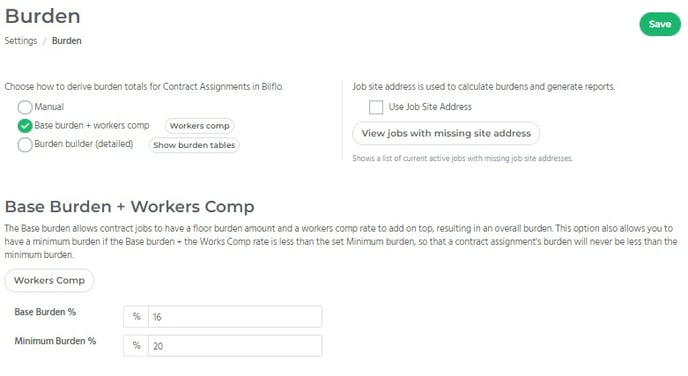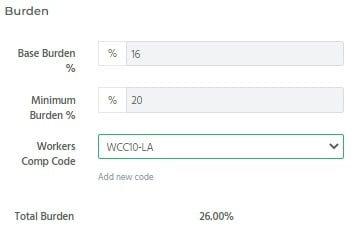This article covers how the Base burden + workers comp setting works in a contract assignment.
Using Base burden + workers comp allows users to set up a base burden, which is a floor burden amount. The base burden plus the workers comp amount will produce the total burden.
This method also allows the user to set a minimum burden percentage. The minimum burden percentage is the lowest possible rate for the total burden. If the Base Burden + Workers Comp Rate is less than the Minimum Burden %, the Minimum Burden % will take precedence.
For example, if the base burden is 16% and the minimum burden is 20%, the Workers Comp rate would have to be at least 4% or the minimum burden rate will activate.
Examples will be provided later in this article to illustrate the effect of minimum burdens and base burdens.
To set up burdens using the base burden method, from the Navigation, select Settings and then select Burdens. You will be directed to the Burdens page.
Select Base Burden + Workers Comp. Now you can define the Base Burden and minimum burden.

Set the Base Burden %. The Base Burden is a value for the floor burden. The Base Burden and Workers Comp rate will determine the overall burden.
Set the Minimum Burden %. The Minimum Burden % is the lowest possible rate of the overall burden.
Once the rates have been entered, select Save. The Base Burden + Workers Comp method will now be utilized in new contract assignments.
The Burdens section of the new contract assignment now populates with the fields Base Burden %, Minimum Burden % and Workers Comp Code. For more information on creating a new contract assignment see the article Create a New Contract Assignment. The values for Base Burden % and Minimum Burden % auto populate with the values saved on the Burdens page.

Select a Workers Comp Code from the dropdown menu. There may be a need to create a new Workers Comp Code. Please see the article How to Add Workers Comp Codes for more information on this process.
Once selected, the Total Burden for the contract assignment will be calculated and will be displayed in the Burden section.
We will now illustrate the effect of minimum burdens and base burdens. For the following examples the Base Burden % is set to 16% and the Minimum Burden is set to 20%.
If a Workers Comp Code is selected that is more than 4% (the difference between the Base Burden and the Minimum Burden). The Total Burden will equal the Base Burden + the Workers Comp Rate. In this example, the Workers Comp rate is equal to 10% making the Total Burden 26%.

If a Workers Comp Code is selected that is less than 4% (the difference between the Base Burden and the Minimum Burden). The Total Burden will equal the Minimum Burden % of 20%. In this case the Workers Comp Rate is 2%.

For more information on Burdens, see the article How to Set Up and Select Burdens.
